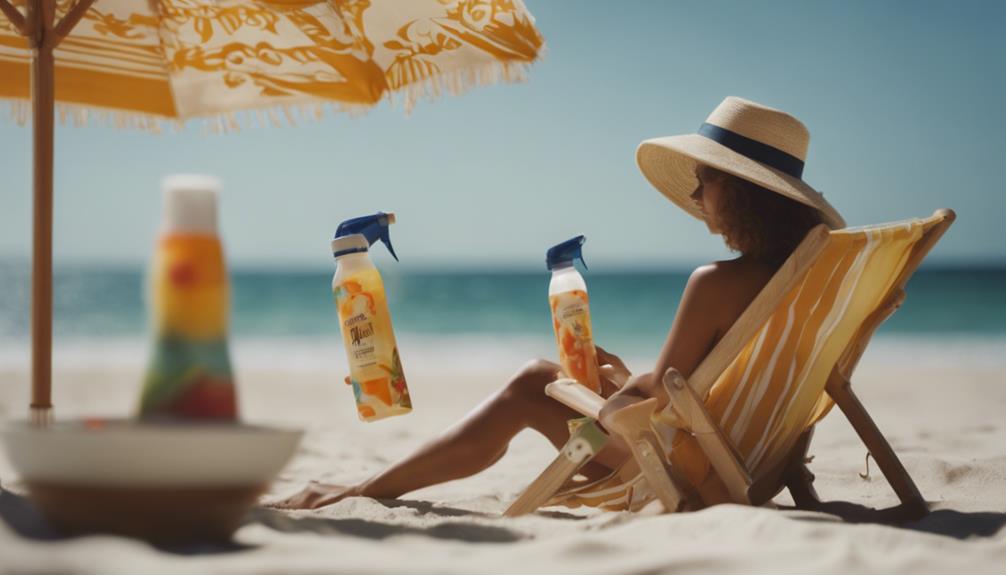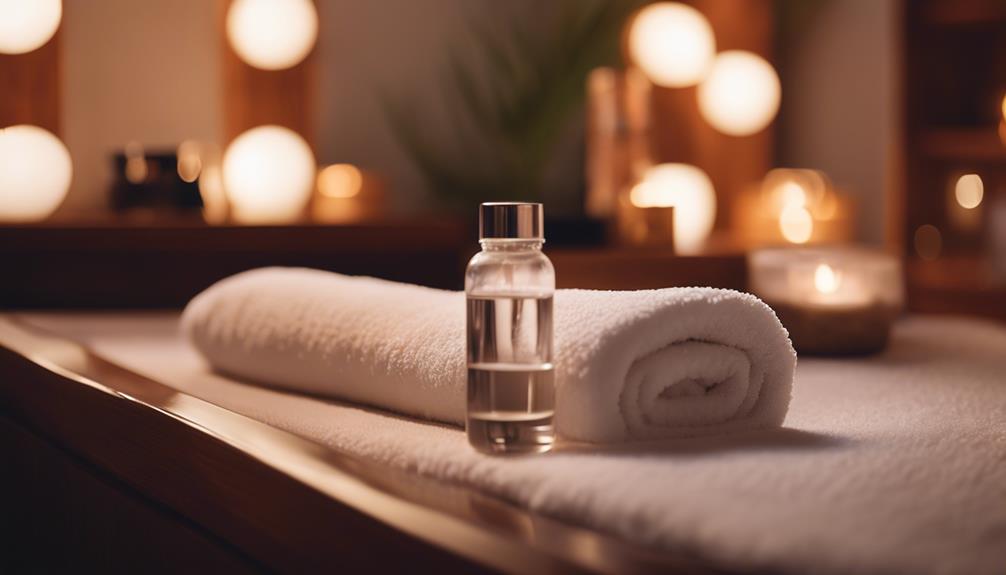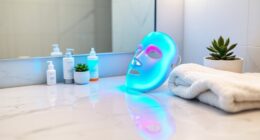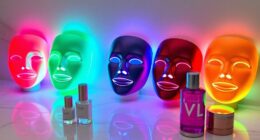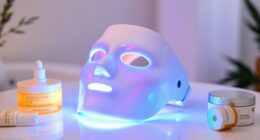To master tanning without turning into a human crab, start by knowing your skin type! Fair skin burns quickly, so keep sessions short, while darker skin can soak up more sun. Grab a good tanning lotion—look for aloe vera or SPF to protect your skin. Remember to exfoliate 24 hours before, stay hydrated, and set a timer during tanning to avoid overdoing it. Don't forget your goggles and SPF lip balm! Afterward, cool your skin with a shower and apply moisturizing aloe to soothe. Stick around, and you might just uncover more fabulous tips to keep your glow and skin healthy!
Key Takeaways
- Start with short tanning sessions to gauge your skin's reaction and prevent burns.
- Always apply a tanning-specific lotion with SPF for added protection against UV rays.
- Use protective accessories like goggles and SPF lip balm to safeguard sensitive areas.
- Clean tanning beds before use to avoid exposure to germs that can irritate the skin.
Understanding Skin Type
Understanding your skin type is essential for determining how it reacts to UV rays and helps you avoid burns while tanning.
First, figure out if you have fair, medium, or dark skin. Fair skin burns like toast in a toaster, while darker skin can tolerate more sun. Knowing your type lets you choose the right tanning session duration—short and sweet for fair skin, longer for darker types.
Remember to prep your skin! Exfoliate 24 hours before tanning to slough off those dead skin cells, and hydrate like a camel leading up to your session. Avoid alcohol-based products that can dry you out, and drink plenty of water!
With the right prep, you'll be on your way to a brilliant tan without the burn.
Choosing Tanning Lotions

Selecting the right tanning lotion can greatly enhance your tanning experience and help protect your skin from burns. You'll want to look for lotions packed with moisturizers like aloe vera or shea butter, and don't forget about SPF to shield your skin from harmful UV rays. Check out the table below to guide your choices:
| Lotion Type | Benefits | Key Ingredients |
|---|---|---|
| Moisturizer | Hydrates skin | Aloe Vera, Shea Butter |
| Bronzer | Instant tan boost | Dihydroxyacetone (DHA) |
| Accelerator | Speeds up tanning process | Tyrosine |
| SPF Lotion | Protects against UV damage | SPF 15 or higher |
| Post-Tan Lotion | Soothes and hydrates skin | Aloe Vera, Vitamin E |
Make sure to apply evenly to avoid that patchy look! Happy tanning!
Safe Tanning Practices

Choosing the right tanning lotion is just the first step; setting safe tanning practices is essential to prevent burns and achieve the best results.
Start by limiting your tanning sessions—think of it like dipping your toes in a pool before diving in! Begin with short sessions to see how your skin reacts, then gradually increase the time if you're feeling good. Always set a timer; you don't want to turn into a lobster!
When tanning, skip regular lotions and stick with ones made for tanning beds. And remember, clean those tanning beds before you jump in; nobody wants to share their sunshine with germs!
With these practices, you'll be well on your way to a fabulous tan without the burn.
Protective Accessories

Protective accessories are essential for safeguarding your skin and eyes during tanning sessions. You wouldn't want to end up looking like a lobster, right? So, gear up with these must-have items:
- Goggles: Protect your eyes from harmful UV rays while still catching some rays on your skin.
- SPF Lip Balm: Keep your lips safe and moisturized, preventing that unsightly sunburned look.
- Cover-Ups: Use towels or special stickers to shield sensitive areas; trust me, your skin will thank you later!
With these accessories in your tanning toolkit, you'll be better prepared to enjoy the sun without the burns.
Post-Tanning Care

After tanning, it's important to hydrate your skin to help maintain that beautiful glow and prevent peeling.
First things first, take a cool shower to wash off any excess tanning products, but don't use hot water—it can dry out your skin.
Once you're out, slather on some aloe vera gel; it's like a cool hug for your skin!
Next, grab a lightweight moisturizer to keep things hydrated without clogging those precious pores.
Remember to check your skin for any signs of peeling, and treat it gently; it's been through a lot!
If you follow these steps, you'll keep that tan looking fabulous longer, and hey, who doesn't want to strut around like a sun-kissed superstar?
Common Tanning Issues

Many people experience common tanning issues, such as burns, itching, and uneven tans, which can affect the overall tanning experience.
But don't worry, you can tackle these pesky problems head-on! Here are a few tips to keep in mind:
- Burns: Always start with short sessions to see how your skin reacts, and never skip the sunscreen, even indoors!
- Itching: After tanning, hydrate your skin well with a soothing lotion. Aloe vera is your friend here!
- Uneven Tans: Make sure to apply your tanning lotion evenly. Use a mitt or your hands, but don't forget to wash them afterward!
Long-Term Skin Health

Maintaining long-term skin health is essential, especially if you frequently tan, as consistent exposure to UV rays can lead to premature aging and increased skin cancer risk. To keep your skin glowing and healthy, consider these easy tips for protection:
| Skin Care Tip | Description |
|---|---|
| Hydrate | Drink plenty of water to keep your skin moist. |
| Use SPF | Apply sunscreen daily, even when tanning. |
| Regular Check-Ups | Visit a dermatologist for skin exams. |
| Moisturize | Keep your skin soft with a good moisturizer. |
| Limit Tanning Sessions | Avoid overexposure to UV rays. |
Frequently Asked Questions
How Often Should I Tan for Optimal Results?
To achieve ideal results, you should tan 2-3 times a week, gradually increasing sessions based on your skin type. Always listen to your body and adjust frequency to avoid overexposure and maintain healthy skin.
Can I Tan if I Have Skin Conditions?
If you have skin conditions, consult a dermatologist before tanning. They'll help you understand potential risks and recommend safe practices. It's crucial to prioritize your skin's health while considering tanning options.
What Should I Do if I Accidentally Over-Tan?
"An ounce of prevention is worth a pound of cure." If you've over-tanned, cool your skin with aloe vera, hydrate, avoid further UV exposure, and consult a dermatologist if severe irritation or peeling occurs.
Are There Age Restrictions for Using Tanning Beds?
Yes, there are age restrictions for using tanning beds. Most places require users to be at least 18 years old. Always check local regulations, as some areas have stricter rules regarding youth access to tanning beds.
Can I Use Regular Sunscreen Instead of Tanning Lotion?
You can't use regular sunscreen instead of tanning lotion. Tanning lotions are specifically formulated for tanning beds, enhancing results and protecting your skin. Regular sunscreen isn't designed for that environment and may not provide adequate protection.
Conclusion
So, as you plunge into your tanning adventure, remember to be smart about it!
You want that gorgeous, golden glow, not the lobster look, right?
By knowing your skin type, picking the right lotions, and following safe practices, you can enjoy the sun while keeping your skin happy.
Just think—wouldn't it be great to show off a tan that turns heads without the painful burns?
Embrace these tips, and you'll shine beautifully this season!
